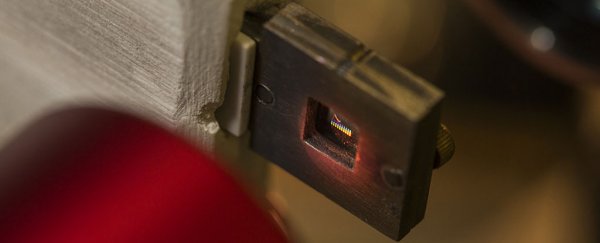If there's one thing that's standing between us and the dream of safe long-haul space travel, it's the threat of radiation in space – which can seriously endanger astronauts' health once they pass outside of Earth's protective magnetosphere for any extended period.
While fixing that problem won't be easy, a new invention from scientists in Australia could indicate a new avenue for mitigating at least some of the radiation in space, thanks to a nano-material that can alternate between reflecting and transmitting light.
Led by physicists Yuri Kivshar and Lei Xu from Australian National University (ANU), the team says their metasurface is so small that hundreds of layers of it could fit on the tip of a needle, meaning the material could readily be applied to any surface or structure, including spacesuits.
"Our invention has a lot of potential applications," says Mohsen Rahmani, one of the researchers, "such as protecting astronauts or satellites with an ultra-thin film that can be adjusted to reflect various dangerous ultraviolet or infrared radiation in different environments."
It's worth pointing out that the nano-material at present can't shield all the harmful effects of cosmic radiation, as it only blocks light – not the harmful, massive particles that make up cosmic rays. But it's a promising way to curb harmful light that could also be dangerous to space travellers.
The key to the nano-material's protective powers is temperature. When the device is heated or cooled, the surface – composed of a 2D lattice of nanoparticles – can be reversibly tuned to either reflect or conduct light waves, including visible light.
 ANU
ANU
What that means is that, in addition to shielding astronauts from cosmic rays, the technology could also be implemented back on Earth for somewhat less dramatic purposes, where the tuning mechanism could be used to transform surfaces between opaque and transparent states.
"For instance, you could have a window that can turn into a mirror in a bathroom on demand," says another member of the team, Andrey Miroshnichenko, "or control the amount of light passing through your house windows in different seasons."
The researchers think that these kinds of applications could lead to new directions in architecture, with reversible mirror/windows that change as needed during the day, potentially cutting down on energy costs by facilitating natural lighting and heating in place of electric substitutes.
Of course, you'd still need to heat or cool the nano-material to trigger the transition in the metasurface, but the team says doing so is relatively easy.
"Much like your car has a series of parallel resistive wires on the back windscreen to defog the rear view, a similar arrangement could be used with our invention to confine the temperature control to a precise location," says Lei Xu.
 ANU
ANU
The device builds on previous research by the team that used similar principles to develop nano-crystals capable of converting invisible light into visible light – which could one day lead to an ultra-thin coating on regular glasses that could effectively turn people's glasses into night vision goggles.
As Fiona MacDonald reported for us late last year:
"In addition to helping build the next-generation of night-vision glasses, the crystal could be used to twist light in all kinds of useful ways.
For example, those holograms on bank notes that prove they're not counterfeit could be created from these light-bending crystals. And they could also produce powerful new holograms."
At present, the nano-material layer has only been demonstrated in the lab, but the team says with the right investment, it might only be two to three years before their metasurface could be in production – which could revolutionise space travel (and the humble window) as we know it.
You can find out more about the nano-material in the video below:
The findings are reported in Advanced Functional Materials.
Edit: this article has been updated to clarify that the invention can't protect astronauts from all aspects of cosmic radiation.
